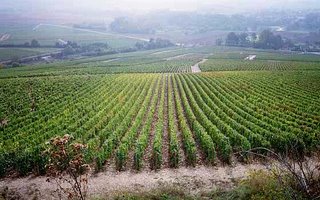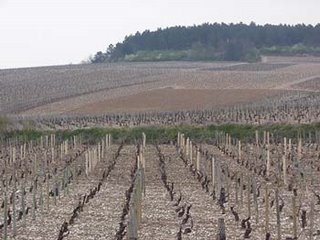
Over the next few months I shall, no doubt, be posting quite often about French wines, as I am planning to attend a couple of courses in wine making and wine appreciation at the Oenological Institute in Bergerac.
But in the mean time, to whet your appetite for some of the best, albeit lesser known wines, I share this bit of interesting information that I had not known about before.
The reason, apparently, for the exceptional fresh, crisp and almost "mineral" quality of Chablis wines, is the fact that the Chablis region was once covered by a sea which laid down calcium sediments containing vast numbers of shells, the majority of which were small oysters in the shape of a comma (Ostrea virgula).
At the end of the Jurassic period, the sea disappeared and the following ice age channelled out valleys in the sedimentary rocks that forms the topography that we see today.

This geological age is called The Kimmeridge in reference to the Bay of Kimmeridge in the south of England whose sub soil has the same characteristics. This type of soil is only found in these two places in the world.
The Chablis soils are in fact alternate layers of very compact limestone interspersed with soft layers of clay which holds the fossilised sea shells.
One also finds in the Chablis area portlandian soil which is a layer found covering the kimmeridgian and dates from the Cretatious period. This layer is high in calcium, but with little clay and fossils. It produces wine that is more supple and fruity rather than mineral in character. The wines produced from this soil are principally classed as “Petit Chablis” and less often as a “Chablis”. All other appellations are grown on Kimmeridgian soil. Indeed, the underlying geology (metamorphic gneisses and schists or Mesozoic limestones) usually form part of the definition of an appellation d’origine contrôlée ( or AOC), such as in Beaujolais.

Fascinating! Each rock type is said to produce wine of particular flavour; the Palaeozoic schists and shales subtle flavours, the Jurassic limestone acidic and strong tannins, and the sands rich and silky smooth. The skill of the vigneron is not only in finding which grape varieties grow best on which rock type, soil and climatic setting but also in the fermentation of these different juices, their assembly -- different proportions of juices from the different parcels of the vineyards, and then maturation in oak barrels -- of different types of oak fired to different degrees, to produce his different wines for marketing.
Thus the rich and smooth taste results from a combination of geological, climatic, botanical and oenological factors. Near Cahors on the river Lot where the wines grow in Jurassic and Cretaceous limestones and a thick iron-rich soil (with siderite and haematite) which developed as a Tertiary terra rossa soil on top of the Mesozoic limestones. The growers here are adamant that the different rock types produce very different wines but with different grape varieties in the different areas and the subsequent assembly of the wine, produce a delicious aromatic, spicy and fruity rich red wine.
Here in the southwest France, the geology is dominated by the nearby Pyrenees. Since Oligocene times fluvial drainage systems developing from the uplifting Pyrenean mountain belt have transported sediment to the north into the Aquitaine Basin. The resulting clays, silts, sands and pebbly conglomerates (les poudingues) have been eroded into steep-sided valleys in the Jurançon area to the south of Pau. Here the climate is dominated by moist winds coming in from the Atlantic and contrasts significantly with the arid, Mesozoic limestone dominated areas to the east. Vines, which prefer to grow on well-drained soils, grow here on the tops of the hills and north-south oriented ridges in between the valleys and river systems that still drain the Pyrenees today. A speciality of this region is a rich sweet and spicy white wine produced from the late harvesting of sun dried, petit manseng grapes (or rather raisins)-- the beautiful smooth sweet Monbazillac I wrote about earlier. The locals drink this as an aperitif along with lashings of pâté de foie gras -- a combination made in heaven!

The geology of the Bordeaux wine region has been formed since Eocene times by river systems draining northwestwards off the Pyrenees. Today the Dordogne river and its tributaries wind through broad valleys into the Bay of Biscay. Overlying the Eocene alluvial sediments are more alluvial clays and sands of Oligocene age. Oligocene seas then transgressed, over the region and shelly limestones (Calcare d’asteries) the dominant building stone of the affluent towns and chateaux of St Emilion, Lussac and St Michel de Fronsac. The room and pillar excavation of this limestone for building stone provides excellent caves for wine storage with their stable year-round temperatures. Following limestone deposition the Oligocene seas subsequently retreated to the west and the ancestral Dordogne and its tributaries eroded into these limestones, clays and sands to deposit a series of Quaternary river terraces which produce some of the classic wines of the area ---Chateaux Figeac and Petrus.
So why are these wines of such high quality? The pundits discuss the importance of the well-drained soils of the river terraces and the underlying clays that restrict vine growth. This generally leads to a concentration of flavour in the grapes. The rest you have to put down to the combination of the cabernet and merlot grapes and the 2000 years of French expertise in winemaking and storage in this region.
(I thank Professor Dan Bosence, BSc Geology (London), PhD (Reading), Professor of Geology for much of this information)
The Chateau Lalinde provides the perfect base from where to attend not only excellent courses in wine tasting and wine appreciation, but also to go on extended and leisurely wine tasting tours. In fact, why not combine a wine tasting tour with an added interest in the geology of the wine country, and go back home and impress your friends not only with your samples of wonderful wines, but also your knowledge of the its origins!
Click on Link:
Chateau Lalinde : The perfect venue for your event
Wines of the Southwest and Bergerac
TAGS: Events in a chateau Rent a chateau France
Special Events Chateau Lalinde Perigord Dordogne Holidays in France Wine Tasting in France French Wines Kimmeridgian Portlandian Geology for wine growing Chablis Wine






